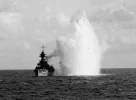Fremen
Greatest Leader
Kamelin kyttyrä, englanniksi hump - The Hump... sorry oli vähän liikaa google-pelon puraisema kyssäri. Jatkakaa kuka haluaa, olen Brightonissa tänään niin taidan polkaista rannalle pällistelemään Atlanttia ja sitten pubiin. Mazel tov!
https://en.wikipedia.org/wiki/The_Hump
The India-China airlift delivered approximately 650,000 tons of materiel to China at great cost in men and aircraft during its 42-month history.[5] For its efforts and sacrifices, the India-China Wing of the ATC was awarded the Presidential Unit Citation on 29 January 1944 at the personal direction of President Franklin D. Roosevelt,[6] the first such award made to a non-combat organization.
Flying over the Hump proved to be an extremely hazardous undertaking for Allied flight crews. The air route wound its way into the high mountains and deep gorges between north Burma and west China, where violent turbulence, 125 to 200 mph (320 km/h) winds,[23][105] icing, and inclement weather conditions were a regular occurrence. Lack of suitable navigational equipment, radio beacons, and inadequate numbers of trained personnel (there were never enough navigators for all the groups) continually affected airlift operations.
Gen. Tunner's final report stated that the airlift "expended" 594 aircraft.[93][bc] At least 468 American and 41 CNAC aircraft were known lost from all causes, with 1,314 air crewmen and passengers killed. In addition, 81 more aircraft were never accounted for, with their 345 personnel listed as missing. Another 1,200 personnel had been rescued or walked back to base on their own.
https://en.wikipedia.org/wiki/The_Hump
The India-China airlift delivered approximately 650,000 tons of materiel to China at great cost in men and aircraft during its 42-month history.[5] For its efforts and sacrifices, the India-China Wing of the ATC was awarded the Presidential Unit Citation on 29 January 1944 at the personal direction of President Franklin D. Roosevelt,[6] the first such award made to a non-combat organization.
Flying over the Hump proved to be an extremely hazardous undertaking for Allied flight crews. The air route wound its way into the high mountains and deep gorges between north Burma and west China, where violent turbulence, 125 to 200 mph (320 km/h) winds,[23][105] icing, and inclement weather conditions were a regular occurrence. Lack of suitable navigational equipment, radio beacons, and inadequate numbers of trained personnel (there were never enough navigators for all the groups) continually affected airlift operations.
Gen. Tunner's final report stated that the airlift "expended" 594 aircraft.[93][bc] At least 468 American and 41 CNAC aircraft were known lost from all causes, with 1,314 air crewmen and passengers killed. In addition, 81 more aircraft were never accounted for, with their 345 personnel listed as missing. Another 1,200 personnel had been rescued or walked back to base on their own.

 .
.

